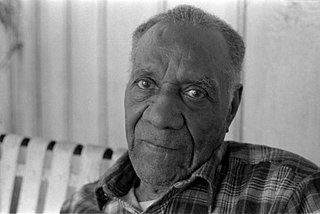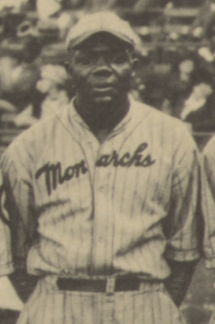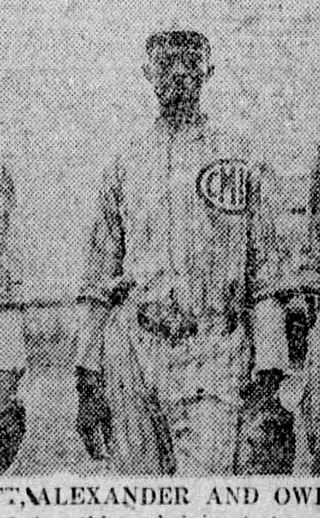Related Research Articles
The first Negro National League (NNL) was one of the several Negro leagues that were established during the period in the United States when organized baseball was segregated. The league was formed in 1920 with former player Rube Foster as its president.

Willie James Wells, nicknamed "the Devil", was an American baseball player. He was a shortstop who played from 1924 to 1948 for various teams in the Negro leagues and in Latin America.
The Chicago American Giants were a Chicago-based Negro league baseball team. From 1910 until the mid-1930s, the American Giants were the most dominant team in black baseball. Owned and managed from 1911 to 1926 by player-manager Andrew "Rube" Foster, they were charter members of Foster's Negro National League. The American Giants won five pennants in that league, along with another pennant in the 1932 Negro Southern League and a second-half championship in Gus Greenlee's Negro National League in 1934.

The Bacharach Giants were a Negro league baseball team that played in Atlantic City, New Jersey.

Walter "Dobie" Moore was an American shortstop and right-handed batter in the Negro leagues who played his entire career with the Kansas City Monarchs of the Negro National League. His career ended after only seven seasons when he shattered his already injured leg while escaping a woman who had shot him.
The Columbus Buckeyes were a Negro league baseball team that played for a single season, 1921, in the Negro National League.
The Indianapolis ABCs were a Negro league baseball team that played both as an independent club and as a charter member of the first Negro National League (NNL). They claimed the western championship of black baseball in 1915 and 1916, and finished second in the 1922 NNL. Among their best players were Baseball Hall of Fame members Oscar Charleston, Biz Mackey, and Ben Taylor.

William Miller "Big Bill" Gatewood was an American Negro league baseball pitcher and manager for several years before the founding of the first Negro National League, and in its first few seasons. He pitched for the Leland Giants, Chicago Giants, St. Paul Colored Gophers, Chicago American Giants, New York Lincoln Giants, Cuban X-Giants, Philadelphia Giants, Brooklyn Royal Giants, St. Louis Giants, Indianapolis ABCs, Detroit Stars, St. Louis Stars, Toledo Tigers, Milwaukee Bears, Memphis Red Sox, Atlantic City Bacharach Giants, and Birmingham Black Barons.

Cornelius Randall Robinson, known professionally as Neil Robinson, was a major league baseball player in the segregated Negro leagues. Also known by the nicknames Neal and Shadow, he primarily played as a center fielder in the 1930s and 1940s, but as a semipro player he alternated between the outfield, shortstop, and third baseman. For the majority of his twenty-three year career, Robinson played for the Memphis Red Sox. Prior to being acquired by Memphis, he played one season for the Homestead Grays and three seasons with the Cincinnati Tigers.

Edgar Wooded Wesley was a Negro league first baseman from 1917 to 1927. He played most of his career with the Detroit Stars of the first Negro National League (NNL).

Alfred "Koke" Alexander was an American Negro leagues outfielder who played with several teams from 1918 to 1921. He played with the Dayton Marcos from 1918 to 1920 before splitting the 1921 season with both the Columbus Buckeyes and Chicago Giants. In 1922, he played for the Colored Men's Improvement team based in Dayton, Ohio.
The 1932 Detroit Wolves baseball team was a Negro league baseball team that competed in the East–West League (EWL) during the 1932 baseball season. The team compiled a 28–9 record and won the EWL pennant, finishing six-and-a-half games ahead of the second-place team. The Wolves played their home games at Hamtramck Stadium in Hamtramck, Michigan.

Edward Rile, nicknamed "Huck", was an American Negro league pitcher and first baseman who played for several teams from 1918 to 1936.
The 1920 Dayton Marcos season was the first season for the franchise in the Negro National League, also in its first season.
The 1926 Dayton Marcos season was the second and final season for the franchise in the Negro National League.
William George Sloan was an American Negro league outfielder and pitcher in the 1900s.
The 1923 Detroit Stars baseball team competed in the Negro National League (NNL) during the 1923 baseball season. The Stars compiled a 41–30 overall record (.577) and 39–27 against NNL opponents. They finished in third place in the NNL.
The 1920 Detroit Stars baseball team competed in the Negro National League (NNL) during the 1920 baseball season. The Stars compiled a 37–27 record (.578) and finished in second place in the NNL behind the Chicago American Giants.
The 1926 Detroit Stars baseball team competed in the Negro National League (NNL) during the 1926 baseball season. The team compiled a 52–47–1 record (.525) and finished fourth in the NNL. The Stars played their home games at Mack Park located on the east side of Detroit, about four miles from downtown, at the southeast corner of Fairview Ave. and Mack Ave. The team was owned by John A. Roesink and managed by Bill Riggins and Candy Jim Taylor.
References
- ↑ "The Dayton Marcos: From the Flood of 1913 to the Dragons of 2000" by Margaret E. Peters, Archived 2014-03-20 at the Wayback Machine
- ↑ "A Game For Today". Palladium-Item . Richmond, IN. August 29, 1909.
- ↑ Richard Worth, Baseball Team Names: A Worldwide Dictionary, 1869-2011 (Jefferson NC and London: McFarland and Inc. Publishers, 2013)
- ↑ "David Garber, Black Ohio and the Color Line, 1860-1915". Archived from the original on 2015-04-02. Retrieved 2015-03-13.
- ↑ "Marcos Play Sunday". The Dayton Herald . June 12, 1909.
- ↑ "Dayton's Baseball History: Ducks, Marcos and More". daytonvistas.com. Retrieved 2021-04-18.
- ↑ "Dayton Hero – Bill G. Sloan". Dayton Unknown. 2016-07-08. Archived from the original on 2021-12-21. Retrieved 2021-12-21.
- ↑ "The Negro National League is Founded". Baseball Hall of Fame. Retrieved 2021-04-18.
- ↑ "Negro Leagues Baseball eMuseum: Personal Profiles: "Candy Jim" Taylor". nlbemuseum.com. Retrieved 2021-04-18.
- ↑ "Clipped from Dayton Daily News". Dayton Daily News. 13 June 1920. p. 35.
- ↑ "1920 Dayton Marcos - Seamheads Negro Leagues Database". seamheads.com. Retrieved 2021-04-20.
- ↑ "1920 Season- Seamheads Negro Leagues Database". www.seamheads.com. Retrieved 2021-04-18.
- ↑ "Colored Clubs Meet". Kokoko Tribune . Kokomo, IN. December 4, 1920.
- ↑ "Baseball Review Of The Past Season". Kansas City Sun . December 25, 1920.
- ↑ Posey, Cumberland (February 6, 1943). "Posey's Points". The Pittsburgh Courier .
- ↑ "Buckeyes 10, Marcos 5". The Dayton Herald . April 27, 1921.
- ↑ "Marco Team to Be in Colored League". The Dayton Herald . April 14, 1923.
- 1 2 "Dayton Marco Team to Play at Westwood". The Dayton Herald . March 29, 1926.
- ↑ "1926 Dayton Marcos - Seamheads Negro Leagues Database". www.seamheads.com. Retrieved 2021-04-20.
- ↑ "Marcos Buy New Players". Dayton Daily News . June 5, 1926.
- ↑ "Joe Hewitt - Seamheads Negro Leagues Database". www.seamheads.com. Retrieved 2021-04-20.
- ↑ "Alex Radcliff - Seamheads Negro Leagues Database". www.seamheads.com. Retrieved 2021-04-20.
- ↑ "Negro Leagues no-hitters | Baseball no-hitters at NoNoHitters.com" . Retrieved 2021-04-20.
- ↑ "1926 Season- Seamheads Negro Leagues Database". www.seamheads.com. Retrieved 2021-04-20.
- ↑ "Formation of Amateur Loop Again Delayed". Dayton Daily News . April 9, 1932.
- ↑ "Dayton Marcos Win E-I Loop Race; Kautskys 2nd". Palladium-Item . Richmond, IN. August 1, 1932.
- ↑ "Raymond Brown – Society for American Baseball Research". Archived from the original on 2020-08-04. Retrieved 2021-04-18.
- ↑ "John Matthews, Negro Sports Figure Dead". The Dayton Herald . May 22, 1942.
- ↑ "Dayton Elks to Meet Merchants at Park Sunday". Greenville Daily Advocate . Greenville, Ohio. August 5, 1943.
- ↑ "Three Games Are On Tap For Local Fans Today". Lexington Herald-Leader . August 10, 1947.
- ↑ "Six-Acre Sucher's Park Sold". The Journal Herald . Dayton, Ohio. April 26, 1952.
- ↑ "Honorees Announced for Dayton Walk of Fame". Dayton Daily News . July 31, 2011 – via Newspapers.com.
- ↑ Archdeacon, Tom. "Archdeacon: Negro Leagues a timeless treasure". dayton-daily-news. Retrieved 2021-12-21.
- ↑ "First 'Dayton Marcos Day' celebrates history of Dayton's Negro League baseball team". WDTN.com. 2021-06-12. Retrieved 2021-12-21.